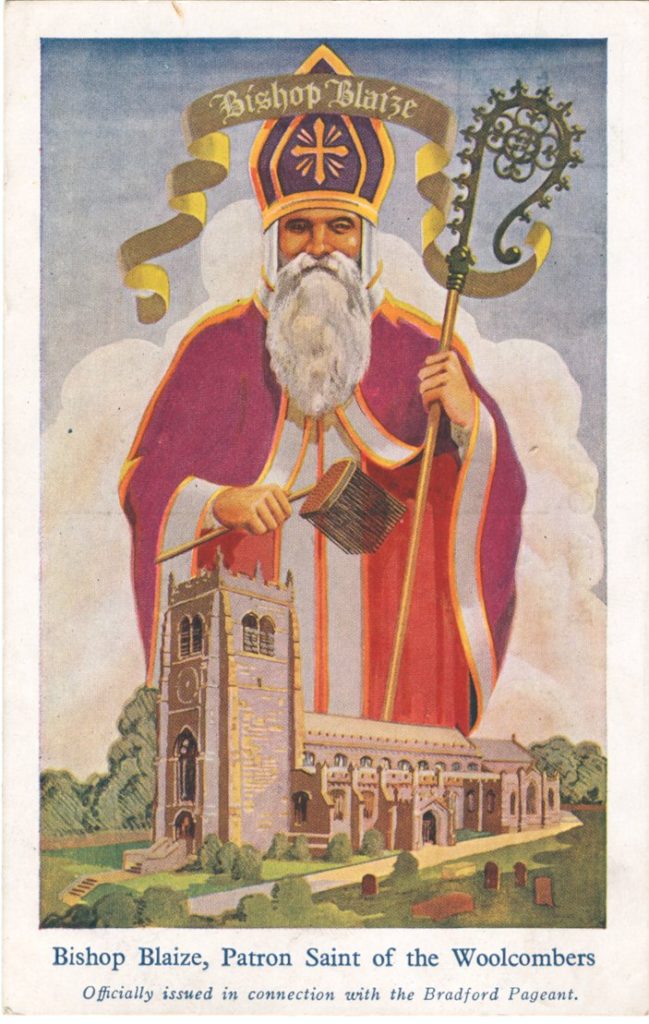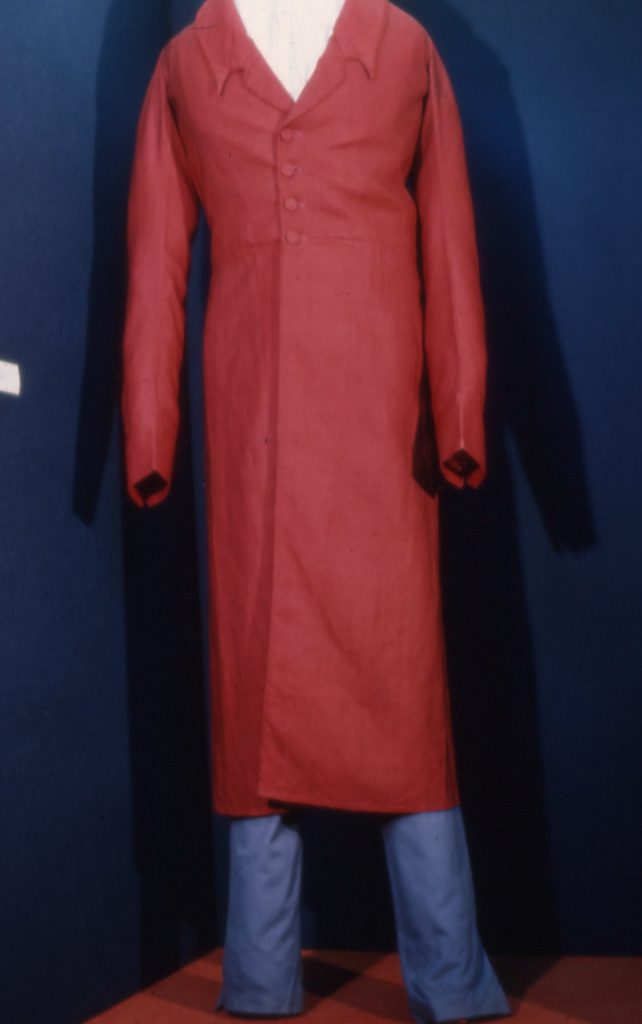This rather fascinating blog, written by our Assistant Curator, Lauren, explores why Saint Blaise, an Armenian doctor and bishop from the 4th century, was celebrated in 19th century Bradford and details upcoming events in Bradford to revive this traditional celebration.
Blaise, the man
Blaise was a physician in historical Armenia, modern day Turkey, in the 3rd – 4th century. Later in life, Blaise retreated to a cave and devoted himself to Christianity, becoming the Bishop of Sebastea. People would travel to him to be cured physically and spiritually. During this time, there was religious tension and persecution throughout Europe. In 316 AD, he was captured and imprisoned. After refusing to renounce Christianity, he was beaten, scourged with iron combs (used to comb or card wool) and beheaded.
Blaise, the saint
The main source of information about Blaise comes from a text written a few centuries after his death, Acts of St. Blaise. This describes how Blaise, when being escorted to prison after his capture, came across a child choking on a fishbone. The child’s mother asked for his help so he prayed for the child and they were cured. It is also claimed that he intervened when a wolf attacked a pig; he returned the pig to the owner, a poor woman, alive and unharmed. When he was awaiting his execution in a dark prison cell, this woman visited him and lit up his dark cell with two wax candles. Due to his dedication to Christianity and his miraculous actions, he became a martyr.
Tales of his actions and death spread quickly and he had a rapid ascent to saint-hood. He was a popular saint throughout Europe from the 11th and 12th century, becoming one of the referred Fourteen Holy Helpers. He was frequently depicted in Medieval iconography with two crossed candles (representing the candles that lit his cell) and with a hand comb (the tool used to torture him). He became the patron saint of sore throats and the patron saint of wool combers. Saint Blaise’s feast day, the 3rd of February, was proclaimed a religious holiday in 1222.
Blaise in Bradford: Then
As Saint Blaise is considered to be the patron saint of wool combers, it is no surprise that he had renewed popularity during the 19th century when the British textile industry boomed. Bradford was at the centre of this industry and so naturally held Saint Blaise in high regard. Every seventh year in Bradford, there were days of celebrations in Saint Blaise’s (or Bishop Blaize’s) honour. Sources indicate that in Bradford there was a Blaise Festival or town-wide celebrations in 1811, 1818 and 1825. It has been suggested that celebrations also occurred in 1804. The 1825 Festival was the largest and thought to the last. However, a festival or celebration of some sort and on some scale was recorded to have happened in 1857. There was also a Bishop Blaize Pageant in 1931 as this postcard proves.

Dr John Simpson, a Bradford doctor, wrote about the 1825 celebration in his diary and described it in detail. On the 2nd of February, he wrote that there had been two months of preparations
by different individuals connected with the trade of the place’ and that Bradford ‘may expect a great influx of strangers, indeed great numbers have arrived today’. His diary entry for the 3rd February, Saint Blaise’s Day, recorded how there had been ‘wind. . . snow and rain’ overnight but it had cleared by morning – ‘the morning was beautiful . . . it seemed as of the weather had taken up purposely for the celebration of the Blaise’. He described how the parade ‘moved from Westgate at 10[am] down Kirkgate, then came up Darley Street and from thence into Rawson Place’ and recalled the parade procession.
‘A herald came first … Then a band of music. Afterwards the Woolstaplers on horseback riding on fleeces ornamented with sashes. Then the Spinners on horseback, with sashes and slivers if wool, blue coats and white stuff waistcoats; their horses covered with white worsted nets. Next. . . the Masters’ Sons and Apprentices on horseback most gaily dressed in scarlet stuff coats, white waistcoats, blue pantaloons, blue sashes and most beautiful caps. . . Next came the Merchants on horseback. . .
Next were people dressed up as
King and Queen. . . Jason and Medea [of the Golden Fleece myth]. . . Bishop Blaise’ passed followed by ‘the Shepherd and Shepherdess. . . Swains on horseback carrying crooks. Then came the Combmakers on horseback with combs and rams’ heads with gilt horns. . . Wool-sorters. . . Master Dyers.
Every professional connected to the wool trade was represented in the parade. Dr Simpson described how ‘The crowd in Bradford was immense for people came from all parts of the country and in all kinds of conveyances.’
On the 4th February, he noted that ‘The Town still in motion and very full’ and that he attended ‘the Blaise Ball’ with ‘one hundred and forty’ in attendance. Although, ‘Nothing particularly interesting occurred. I only danced one quadrille. . . The company was very mixed, but all went off well’. On the 5th February, he wrote that ‘The town still busy. I was to have dined with the Stewards of the Blaise dinner and ball but was prevented. I went in the evening to them and found them very merry.’
In the Bradford Museums and Galleries social history collection, there are several items with connections to 19th century Blaise festivals. There are handbills advertising festivals and items of clothing worn at festivals, including an outfit worn by Richard Fawcett, a Bradford wool merchant, for the 1825 festival. Richard Fawcett was in the parade procession and led the worsted spinners section on horseback.

Blaise in Bradford: Now (2019)
There are still signs of Bradford’s historical affinity to Saint Blaise in the 20th and 21st century. There was a Saint Blaise Middle School in Bradford. Streets are named St Blaise Court and St Blaise Way. The Wool Exchange building (built in 1864-67), has a stone statue of Saint Blaise near the original entrance, carved by sculptor James Tolmie. A building at North Parade, formerly the Church Institute (built in 1871-73 by architects Andrews and Pepper) has a similar head of Saint Blaise carved onto it.
Over the past years, local poet, writer and showman Glyn Watkins has revived the festival through a series of walks, talks and events in Bradford. In 2019, the festival consists of events in Bradford City Centre organised by Glyn on Saturday 2nd February 2019 and a Bring Back Blaise Wool Festival at Bradford Industrial Museum on Sunday 3rd February 2019. At Bradford Industrial Museum, visitors can: explore the spinning and weaving galleries to discover Bradford’s textile history; browse stalls selling wool-related crafts and products; look at a display of St Blaise related objects; take part in family activities and textile demonstrations; meet some friendly and fluffy alpacas; listen to a brass band and choir; and enjoy the food stalls and pop-up *baaaaar* selling craft beers, cask ale and more! So come along and pay homage to Saint Blaise and Bradford’s textile history.
For more details of Bradford Industrial Museum’s Wool Festival 2019, please visit: Bring Back Blaise Wool Festival
For details of the Saturday events, visit Glyn’s Facebook page
Kindly sponsored by Napoleons Casino and Restaurant Bradford, and Salamander Brewing Company


2 Responses
https://www.stblaisebradford.org.uk/
Worth a mention.
Very interesting. Would be good to know the sources for Dr Simpson and Richard Fawcett.